Adansonia gregorii
| Boab | |
|---|---|
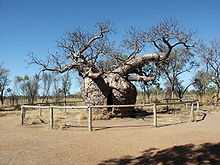 | |
| Adansonia gregorii, the boab | |
| Scientific classification | |
| Kingdom: | Plantae |
| (unranked): | Angiosperms |
| (unranked): | Eudicots |
| (unranked): | Rosids |
| Order: | Malvales |
| Family: | Malvaceae |
| Genus: | Adansonia |
| Species: | A. gregorii |
| Binomial name | |
| Adansonia gregorii F.Muell. | |
Adansonia gregorii, commonly known as the boab, is a tree in the family Malvaceae. As with other baobabs, it is easily recognised by the swollen base of its trunk, which gives the tree a bottle-like appearance. Endemic to Australia, boab occurs in the Kimberley region of Western Australia, and east into the Northern Territory. It is the only baobab to occur in Australia, the others being native to Madagascar (six species) and mainland Africa and the Arabian Peninsula (two species). Boab ranges from 5 to 15 meters in height, usually between 9 and 12 metres, with a broad bottle-shaped trunk.[1] Its trunk base may be extremely large; trunks with a diameter of over five metres have been recorded. A. gregorii is deciduous, losing its leaves during the dry winter period and producing new leaves and large white flowers between December and May.[1]
Alternative names
The common name "boab" is a shortened form of the generic common name "baobab". Although boab is the most widely recognised common name, Adansonia gregorii has a number of other common names, including:[2]
- baobab — this is the common name for the genus as a whole, but it is often used in Australia to refer to the Australian species;
- Australian baobab
- boabab was in common use from the late 1850s[3] (Perhaps the origin of boab)
- baob[4][5]
- bottle tree
- upside down tree
- dead rat tree
- gouty stem tree
- monkey bread tree[3]
- cream of tartar tree
- gourd-gourd tree
- sour gourd
- gadawon — one of the names used by the local Indigenous Australians. Other names include larrgadi or larrgadiy, which is widespread in the Nyulnyulan languages of the Western Kimberley.
The specific name "gregorii" honours the Australian explorer Augustus Gregory.
Uses
The plant has a wide variety of uses; most parts are edible and it is the source of a number of materials. Its medicinal products and the ability to store water through dry seasons has been exploited.[6] Indigenous Australians obtained water from hollows in the tree, and used the white powder that fills the seed pods as a food. Decorative paintings or carvings were sometimes made on the outer surface of the fruit. The leaves were used medicinally.
Notable trees
A large hollow boab south of Derby, Western Australia is reputed to have been used in the 1890s as a lockup for Aboriginal prisoners on their way to Derby for sentencing. The Boab Prison Tree, Derby is now a tourist attraction.[7] Another hollow boab near Wyndham, Western Australia was also used as a prison tree.[8][9][10][11] The Hillgrove Lockup or Wyndham Prison Tree is on the King River Road out of Wyndham near the Moochalabra Dam. Gija Jumulu is a large boab which was transported from Warmun in the Kimberley region of Western Australia to Kings Park in 2008.
Gallery
-
A boab tree in Timber Creek, Northern Territory
-
_-_Nitmiluk_NT.jpg)
Adansonia gregorii in Nitmiluk (Katherine Gorge) NP, Northern Territory.
-
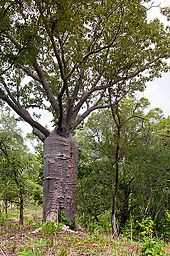
Boab - Katherine River
-
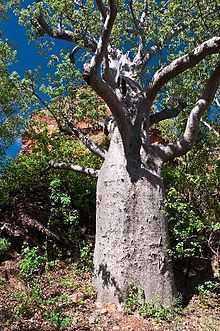
Boab tree near Kununurra WA
-
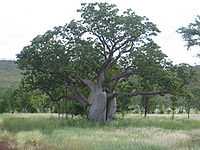
A boab tree in the Kimberley, Western Australia in February
-
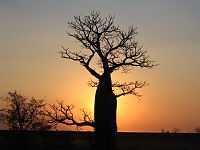
Boab tree sunset near Derby, Western Australia
References
- ↑ 1.0 1.1 "Adansonia gregorii". FloraBase. Department of Environment and Conservation, Government of Western Australia.
- ↑ "Australian plant common name database". Australian National Botanic Gardens. Archived from the original on 25 October 2010. Retrieved 2010-10-11.
- ↑ 3.0 3.1 "Trove Newspaper results for "boabab"". National Library of Australia. Retrieved 2012-01-10.
- ↑ "A "BOOB" IN A BAOB TREE.". The Sydney Morning Herald (National Library of Australia). 31 August 1940. p. 9. Retrieved 11 January 2012.
- ↑ "SOUVENIRS.". The West Australian (Perth: National Library of Australia). 1 September 1928. p. 8. Retrieved 11 January 2012.
- ↑ Vickers, Claudia; Jack Pettigrew. "Origins of the Australian Boab (Adansonia gregorii)". The University of Queensland. Retrieved 8 October 2010.
- ↑ Boab Prison Tree, About-Australia.com. Retrieved 1 February 2009.
- ↑ "SOUVENIRS.". The West Australian (Perth: National Library of Australia). 1 September 1928. p. 8. Retrieved 11 January 2012.
- ↑ "Giant Bottle Trees.". The Queenslander (National Library of Australia). 26 February 1931. p. 54. Retrieved 11 January 2012.
- ↑ "THE BAOBAB.". The Queenslander (National Library of Australia). 26 February 1931. p. 29. Retrieved 11 January 2012.
- ↑ "IN THE FAR NORTH-WEST.". The West Australian (Perth: National Library of Australia). 17 December 1932. p. 5. Retrieved 11 January 2012.
| Wikispecies has information related to: Adansonia gregorii |
- Boland, D. J. et al. (1984). Forest Trees of Australia (Fourth edition ed.). Collingwood, Victoria, Australia: CSIRO Publishing. ISBN 0-643-05423-5.
External links
- "Boab (KHS Group Photographic Pool on Flickr)". Photographs of the Australian Boab – Adansonia gregorii (Includes photographs of both prison trees).
- "Photograph of the Hillgrove Lockup". State Library of South Australia. Retrieved 11 January 2012. Photograph by M.E. McCombe ca.1917-1925.
